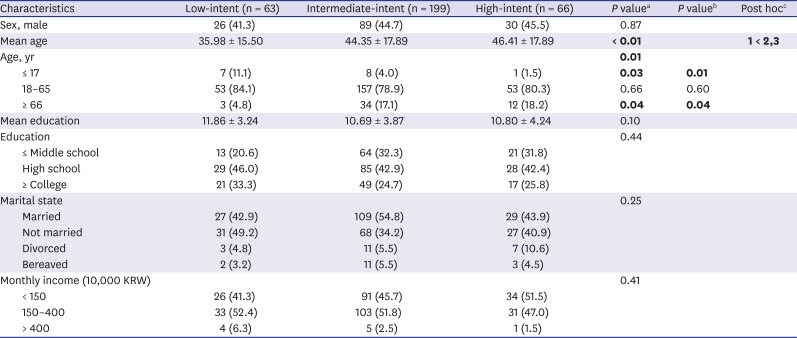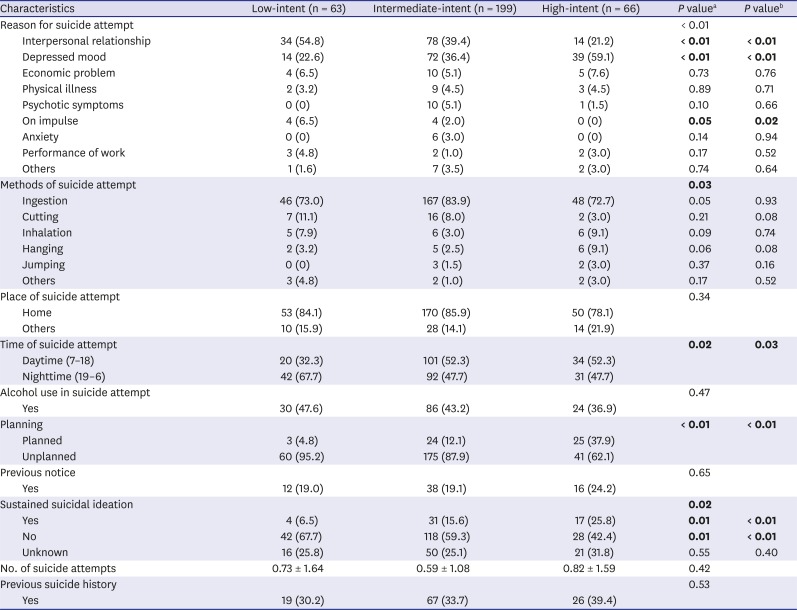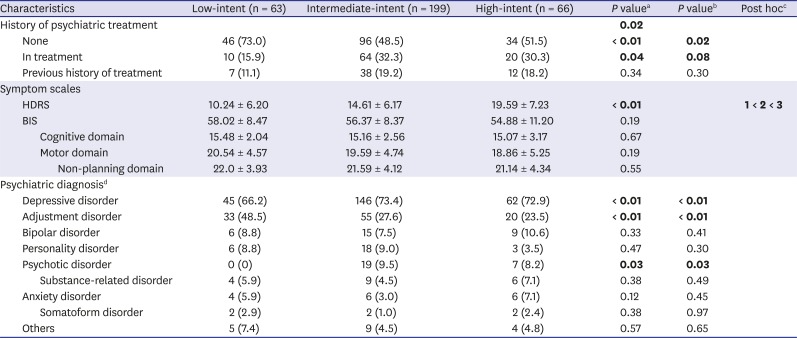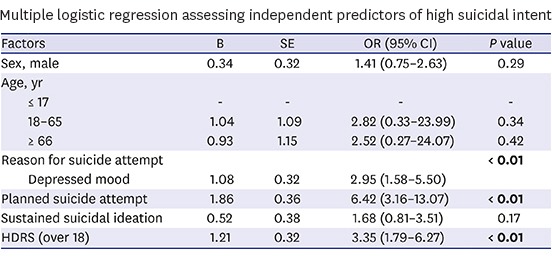3. Ministry of Health and Welfare (KR). Korea Suicide Prevention Center. 2017 White Book. Seoul: Korea Suicide Prevention Center;2017.
4. Marschean A, Kincaid I. Developing a Plan and Strategy for Suicide Prevention in the Commonwealth. Richmond, VA: The Joint Commission;2003.
5. Walsh BW. Treating Self Injury: a Practice Guide. 2nd ed. New York, NY: The Guilford Press;2012.
6. O'Connell H, Chin AV, Cunningham C, Lawlor BA. Recent developments: suicide in older people. BMJ. 2004; 329(7471):895–899. PMID:
15485967.
7. Crump C, Sundquist K, Sundquist J, Winkleby MA. Sociodemographic, psychiatric and somatic risk factors for suicide: a Swedish national cohort study. Psychol Med. 2014; 44(2):279–289. PMID:
23611178.
8. Sisask M, Kõlves K, Värnik A. Severity of attempted suicide as measured by the Pierce Suicidal Intent Scale. Crisis. 2009; 30(3):136–143. PMID:
19767269.
9. Niméus A, én M, Träskman-Bendz L. High suicidal intent scores indicate future suicide. Arch Suicide Res. 2002; 6(3):211–219.
10. Kim MD, Hong SC, Lee SY, Kwak YS, Lee CI, Hwang SW, et al. Suicide risk in relation to social class: a national register-based study of adult suicides in Korea, 1999–2001. Int J Soc Psychiatry. 2006; 52(2):138–151. PMID:
16615246.
11. Park SH, Lim DO. Daily and monthly death pattern an intentional self-harm by hanging, strangulation and suffocation in Korea, 2011. Health Policy Manag. 2013; 23(3):260–265.
12. Jeon HJ, Lee JY, Lee YM, Hong JP, Won SH, Cho SJ, et al. Lifetime prevalence and correlates of suicidal ideation, plan, and single and multiple attempts in a Korean nationwide study. J Nerv Ment Dis. 2010; 198(9):643–646. PMID:
20823725.
13. Hur JW, Choi KY, Lee BH, Shim SH, Yang JC, Kim YK. The psychosocial factors affecting suicide attempt. J Korean Neuropsychiatr Assoc. 2007; 46(2):129–135.
14. Kwon JW, Ko YH, Han CS, Lee MS, Yoon HK, Lee H. Psychosocial characteristics and factors associated with referral to psychiatric care in the suicide attempters visiting emergency center. Korean J Psychosom Med. 2013; 21(2):106–113.
15. Lim M, Lee S, Park JI. Characteristics of Korean suicide attempters. J Korean Neuropsychiatr Assoc. 2015; 54(2):209–215.
16. American Psychiartric Association. Diagnostic and Statistical Manual of Mental Disorders, 4th Edition, Text Revision (DSM-IV-TR). Washington, D.C.: American Psychiatric Association;2000.
17. Pierce DW. Suicidal intent in self-injury. Br J Psychiatry. 1977; 130(4):377–385. PMID:
870128.
18. Hamilton M. A rating scale for depression. J Neurol Neurosurg Psychiatry. 1960; 23(1):56–62. PMID:
14399272.
19. Yi JS, Bae SO, Ahn YM, Park DB, Noh KS, Shin HK, et al. Validity and reliability of the Korean version of the Hamilton Depression Rating Scale (K-HDRS). J Korean Neuropsychiatr Assoc. 2005; 44(4):456–465.
20. Bagby RM, Rector NA, Bacchiochi JR, McBride C. The stability of the response styles questionnaire rumination scale in a sample of patients with major depression. Cognit Ther Res. 2004; 28(4):527–538.
21. Barratt ES. Impulsivity: integrating cognitive, behavioral, biological, and environmental data. In : McCown WG, Johnson JL, Shure MB, editors. The Impulsive Client: Theory, Research, and Treatment. Washington, D.C.: American Psychological Association;1993. p. 39–56.
22. Lee SR, Lee WH, Park JS, Kim SM, Kim JW, Shim JH. The study on reliability and validity of Korean version of the Barratt Impulsiveness Scale-11-revised in nonclinical adult subjects. J Korean Neuropsychiatr Assoc. 2012; 51(6):378–386.
24. Harriss L, Hawton K, Zahl D. Value of measuring suicidal intent in the assessment of people attending hospital following self-poisoning or self-injury. Br J Psychiatry. 2005; 186(1):60–66. PMID:
15630125.
25. Park JH, Wi DH. Clinical analysis of the suicidal attempters visiting emergency center. J Korean Soc Emerg Med. 1999; 10(4):568–578.
26. Brown GK, Beck AT, Steer RA, Grisham JR. Risk factors for suicide in psychiatric outpatients: a 20-year prospective study. J Consult Clin Psychol. 2000; 68(3):371–377. PMID:
10883553.
27. Harris EC, Barraclough B. Suicide as an outcome for mental disorders. A meta-analysis. Br J Psychiatry. 1997; 170(3):205–228. PMID:
9229027.
28. Lim M, Kim SW, Nam YY, Moon E, Yu J, Lee S, et al. Reasons for desiring death: examining causative factors of suicide attempters treated in emergency rooms in Korea. J Affect Disord. 2014; 168:349–356. PMID:
25103630.
29. Jeon HJ, Lee JY, Lee YM, Hong JP, Won SH, Cho SJ, et al. Unplanned versus planned suicide attempters, precipitants, methods, and an association with mental disorders in a Korea-based community sample. J Affect Disord. 2010; 127(1-3):274–280. PMID:
20591495.
30. Lee CA, Choi SC, Jung KY, Cho SH, Lim KY, Pai KS, et al. Characteristics of patients who visit the emergency department with self-inflicted injury. J Korean Med Sci. 2012; 27(3):307–312. PMID:
22379343.
31. Krishna M, Rajendra R, Majgi SM, Heggere N, Parimoo S, Robinson C, et al. Severity of suicidal intent, method and behaviour antecedent to an act of self-harm: a cross sectional study of survivors of self-harm referred to a tertiary hospital in Mysore, South India. Asian J Psychiatr. 2014; 12:134–139. PMID:
25441305.
32. Choi DC, Kim HR, Kim CH, Park SH, Kim SH, Cho YR. Sociodemographic characteristics of the suicide attempters visiting emergency room. Korean J Psychopathol. 2000; 9(1):36–49.
33. Kim J, Seo WS, Lee JH, Kim HC, Lee K, Won S. Characteristics of suicide attempters admitted to the emergency departments of university hospitals: demographic and psychosocial data. J Korean Soc Biol Ther Psychiatry. 2015; 21(2):95–104.
34. Scocco P, Marietta P, Tonietto M, Dello Buono M, De Leo D. The role of psychopathology and suicidal intention in predicting suicide risk: a longitudinal study. Psychopathology. 2000; 33(3):143–150. PMID:
10773773.
35. Harriss L, Hawton K. Suicidal intent in deliberate self-harm and the risk of suicide: the predictive power of the Suicide Intent Scale. J Affect Disord. 2005; 86(2-3):225–233. PMID:
15935242.
36. Beck AT, Steer RA. Clinical predictors of eventual suicide: a 5- to 10-year prospective study of suicide attempters. J Affect Disord. 1989; 17(3):203–209. PMID:
2529288.
37. Jung HY, Roh SH. A study on factors influencing elderly suicidal ideation: focused on the mediating effects of depression and stress on suicidal ideation. J Korean Gerontol Soc. 2007; 27(4):789–805.
38. Kawanishi C, Aruga T, Ishizuka N, Yonemoto N, Otsuka K, Kamijo Y, et al. Assertive case management versus enhanced usual care for people with mental health problems who had attempted suicide and were admitted to hospital emergency departments in Japan (ACTION-J): a multicentre, randomised controlled trial. Lancet Psychiatry. 2014; 1(3):193–201. PMID:
26360731.









 PDF
PDF Citation
Citation Print
Print




 XML Download
XML Download